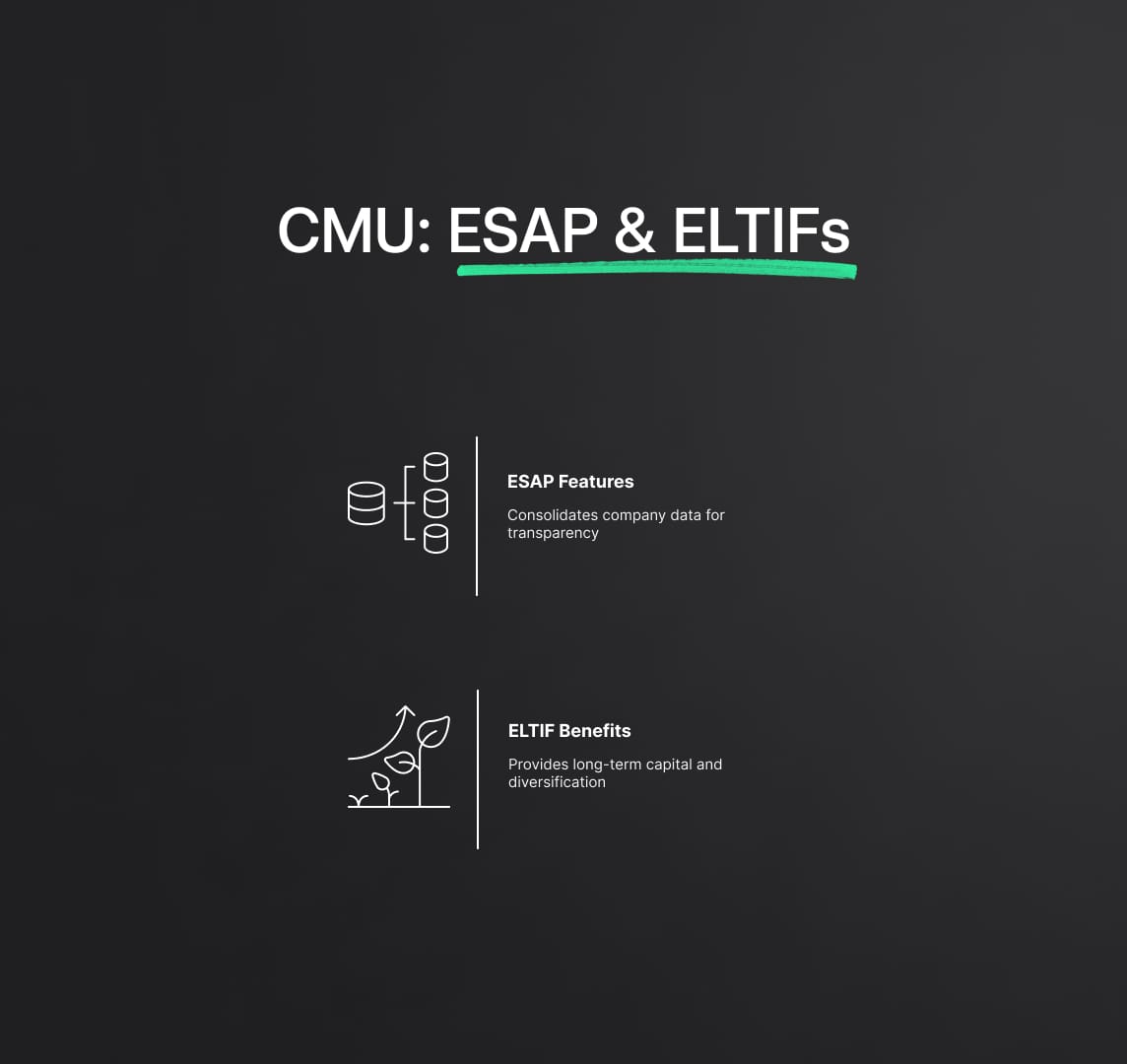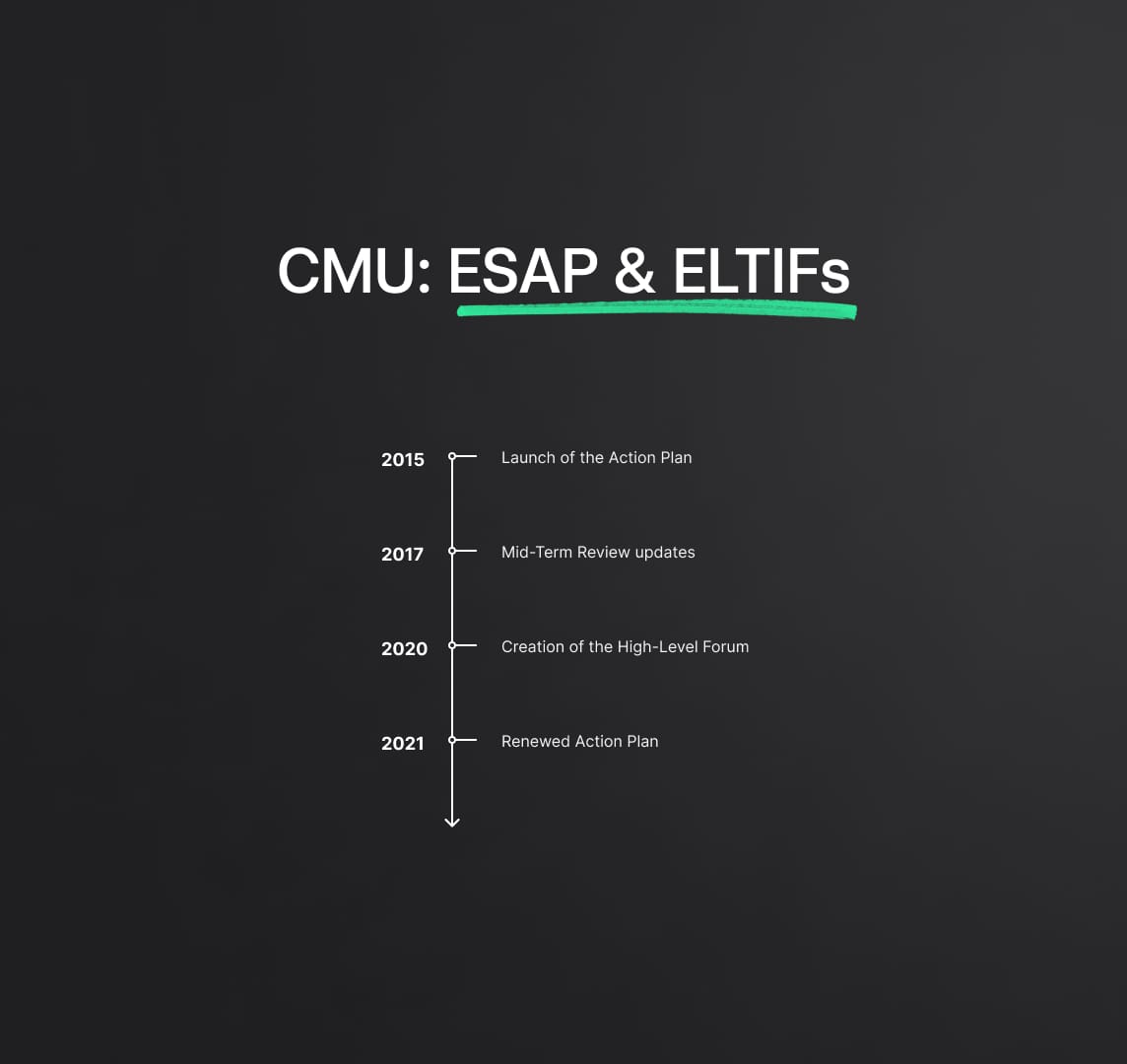Capital markets union : How it Impacts EU Financial system?
Explore the intricate regulatory landscape shaping the European Union's Capital Markets Union (CMU), including in-depth insights into the Alternative Investment Fund Managers Directive (AIFMD2), European Single Access Point (ESAP), and European Long-Term Investment Funds (ELTIFs).

Grand “Answer”:
The Capital Markets Union (CMU) is a strategic initiative of the European Union designed to integrate national capital markets into a single market across Europe [1] [3]. Its primary objective is to facilitate free movement of capital within EU member states, aiming to enhance the efficiency of the financial system by diversifying its funding sources and creating opportunities for both savers and investors [1][2]. The CMU seeks to channel investments and savings across the EU in a way that benefits consumers, investors, and businesses, irrespective of their location [1][3]. By doing so, it aims to boost economic growth, create jobs, and stimulate investment activities within the EU [1][3]. In summary, the Capital Markets Union is all about enhancing the financial ecosystem within the European Union, fostering economic growth, and creating a more inclusive investment environment [1][2][3].
Source
[1]
EU's Capital Markets Union: The Regulatory Backbone
The European Union's Capital Markets Union (CMU) symbolizes an ambitious leap towards a truly unified capital market across the member states. Since its genesis in 2015, the CMU has been powered by a well-articulated vision of fuelling economic prosperity, diversifying financial risk, and fostering investment opportunities. Now, in 2023, an exploration of the regulatory intricacies that are the bedrock of the CMU provides illuminating insights into its evolution, present state, and future potential.
The CMU, at its heart, holds the strategic objectives of enabling seamless capital mobility within Europe. The primary beneficiaries are businesses and infrastructure projects, with an emphasis on Small and Medium-sized Enterprises (SMEs). Such capital movements stimulate job creation, economic growth, and enhance the overall resilience of the EU's financial ecosystem, strengthening its defenses against potential financial shocks.
The landscape of the CMU presents an array of opportunities for both institutional and retail investors. Diverse investment avenues provide portfolio diversification, allowing for balanced risk distribution and potential for better returns. However, understanding this terrain necessitates familiarity with the regulatory measures shaping the CMU, notably the Alternative Investment Fund Managers Directive (AIFMD).

Capital Markets Union: European Single Access Point (ESAP) and European Long-Term Investment Funds (ELTIFs)
The regulatory landscape of the CMU is continually evolving, with two key components currently under spotlight - the European Single Access Point (ESAP) and European Long-Term Investment Funds (ELTIFs).
The ESAP is a unique proposition that aims to simplify access to financial and non-financial information on EU companies. This information is currently scattered across various national and EU databases, making it difficult for investors to access and compare. The ESAP is envisaged to be a one-stop-shop, offering a single entry point for such information. This will enable investors to make more informed decisions, fostering increased transparency and trust in the market.
In-depth features of the ESAP include:
- Aggregation of company data: ESAP consolidates company-related information from various databases across the EU, eliminating the need for investors to navigate multiple sources.
- Enhanced transparency: By providing comprehensive, accessible information about EU companies, ESAP improves market transparency, which is vital for investor protection.
- Streamlined decision-making: With readily available data, investors can make more informed decisions, leading to optimized investment outcomes.
On the other hand, ELTIFs represent a category of investment funds regulated at the EU level. ELTIFs are designed to increase the amount of non-bank finance available for companies investing in the real economy of the EU. They provide long-term capital to unlisted companies, infrastructure projects, and real estate undertakings that offer social and economic benefits.
Key considerations for ELTIFs include:
- Bridging the funding gap: By providing long-term capital, ELTIFs help bridge the funding gap faced by many projects and businesses across the EU.
- Diversification: ELTIFs allow investors to diversify their portfolios with long-term, non-traditional investments.
- Regulatory protections: As regulated entities, ELTIFs offer investors several protections, including disclosure requirements and restrictions on eligible investments.

Capital Markets Union: AIFMD and AIFMD2
The AIFMD, implemented in 2011, provides a blueprint for the management and marketing of alternative investment funds within the EU. Its scope covers a variety of funds including hedge funds, private equity funds, and real estate funds. AIFMD has a steadfast focus on investor protection, systemic risk reduction, increased transparency, and improved monitoring. These elements form the cornerstones of a stable financial environment.
Fast forward to 2023, we see the introduction of AIFMD2, reflecting the commitment to continually fine-tune the CMU's regulatory environment. This advanced directive introduces pivotal changes aimed at enhancing European asset management market integration, modernizing regulations, strengthening transparency, and bolstering the resilience of the financial system.
One notable addition in AIFMD2 is the expansion in the availability of liquidity management tools (LMTs). Fund managers are now required to activate these tools, enhancing their ability to meet fund obligations, and offering increased protection to investors. Transparency, especially concerning delegation rules, is another major focus area. AIFMD2 mandates supervisors to stay well-informed about the extent of task delegation to third parties, ensuring high levels of oversight and risk management.
AIFMD2 also lays the groundwork for an EU-wide framework for loan-originating funds, which offer direct credit to companies. Recognizing the potential risks to financial stability and investor protection, this initiative is backed by several risk mitigation measures and safeguards for investors.
Future of the Capital Markets Union: Regulatory Adaptations
The CMU has continually adapted to the financial landscape's ebbs and flows since its inception, demonstrating a dynamic response to change. The original 2015 CMU Action Plan proposed 33 actions to break down barriers to cross-border investments and ease access to finance for businesses. The Mid-Term Review in 2017 added new actions to tackle emerging challenges, including enhancing banking capacity, developing personal pensions markets, and harnessing the power of financial technology (FinTech) in the capital markets sector.
However, as 2020 dawned, there was a growing consensus on the need to expedite actions to meet the CMU's objectives, especially against the backdrop of the EU's expanding financing needs. In response, the Commission established the High-Level Forum (HLF) that proposed measures to rejuvenate the CMU. These measures were incorporated into a new CMU action plan endorsed by the Council in 2021.
This revamped plan marked a fresh chapter in the CMU's journey, focusing on diversifying and improving SME financing options, simplifying insolvency laws EU-wide, and boosting retail investors' inclusion. As we step into the future, it is evident that the continual adaptation of the CMU's regulatory frameworks will be instrumental in realizing the Union's lofty vision. Regulations form the backbone of the CMU, influencing its resilience, inclusivity, and prosperity. With the introduction of AIFMD2 and ongoing reforms such as the ESAP and ELTIFs, the CMU's regulatory evolution is poised to provide a more robust, interconnected financial system within the EU.
Grand Answer: Your AI Partner
Designed to support compliance officers, legal counsels, and other professionals responsible for adhering to regulatory standards, Grand Answer aims to facilitate an efficient and straightforward compliance process.
Reduce your
compliance risks


